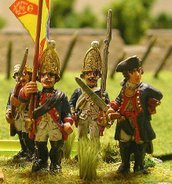The Italians called the complex the "Tabacchificio Fioche". The black and white photo above was taken well after the battle after significant clean up had happened. The rubble and bricks removed presumably for rebuilding efforts elsewhere. To the bottom right of the photo you can see a bridge over a small, but tactically significant river. The factory complex acted as a natural hard point for this key bridge. The British tried to take the complex at least four times and the Americans twice, before the final battle for it secured it permanently for the allies.
This is a modern photo shows the remaining ruins of the complex which have been partially preserved. The key characteristic is the primarily white field with rows of red bricks exposed. Pre-war black and white photos show this pattern to have been part of these buildings construction and not an artifact of wear or damage. To make my tabletop buildings I'd like to replicate at least the theme of this pattern, as much as possible. I've developed some techniques to assist in this using multiple layers of paint and the laser to remove the brick 'strips'. After assembly I'll add battle damage, dirt and grime. Starting with near-pristine patterns will make all the weathering more realistic.
This is the shell of the first of five large buildings. From the photos they come in two forms, one with tall doors and one with normal doors and ventilation windows. This is the latter. I still have additional applique brick work to add around the openings.
Below is the first of the wedge-shaped smaller buildings. This one is temporarily taped together. I still have to hand-sand the bevels in each panel and cut a base for it before assembly.

This is a close-up of a sample I made to test the laser technique. The middle row near the figure's wrist is what is used on the buildings. The bricks are near scale. The buildings are intentionally under-sized to allow the entire complex to fit on a 6' x 8' table and still allow room around it for maneuver. I didn't want fighting the fight like a Stalingrad battle to be the only option.
I still have a long way to go, but at least the techniques look like they'll work. I also have the majority of the computer CAD work done. Now it's just spending the time to make all the buildings, scratch build seven roofs and weather everything. There's also three ruined buildings to make. More on those soon.....

































































